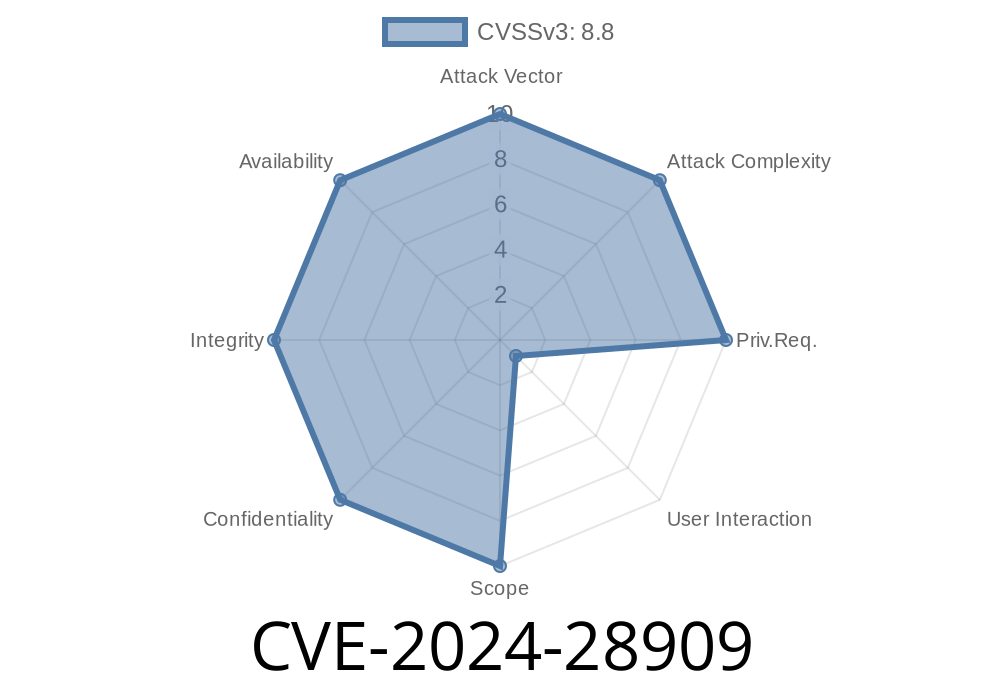On March 12, 2024, Microsoft published an important security advisory for CVE-2024-28909, a remote code execution (RCE) vulnerability affecting the Microsoft OLE DB Driver for SQL Server. In this long read, you'll get a real-world perspective on what this vulnerability involves, how attackers could exploit it, and what you can do to stay safe. Let’s break this down in a beginner-friendly way.
What Is CVE-2024-28909?
CVE-2024-28909 is a vulnerability in the Microsoft OLE DB Driver for SQL Server. OLE DB is a core data access technology, letting applications connect and talk to SQL Server databases.
If a user connects to an attacker’s specially crafted SQL Server using a vulnerable version of the OLE DB Driver, the attacker could execute arbitrary code on the connecting machine. This is a big deal: it means attackers could potentially take over client computers just by tricking them into connecting to a malicious database.
Microsoft rates this as Important because it could lead to full remote code execution.
Who Is At Risk?
- Anyone running applications that connect to remote SQL Servers via OLE DB Driver 18.x or 19.x before the patched version (see table below).
- Commonly affected: web apps, desktop apps, or internal automation tools using SQL Server for storage.
Setup: The attacker sets up a malicious (rogue) SQL Server instance.
2. Hook: A victim’s application—using the vulnerable OLE DB Driver—connects to this rogue server (either intentionally or by being tricked/redirected).
3. Payload: The malicious server responds with specially crafted data which exploits a bug in the OLE DB Client.
4. Execution: This data causes the victim’s OLE DB Client to run code chosen by the attacker—leading to RCE.
This is known as a "client-side remote code execution": the victim must actively connect to the attacker.
Think Your App Is Safe? Check This Example
If you use code like the following, you may be at risk:
using System.Data.OleDb;
string connStr =
"Provider=MSOLEDBSQL;Data Source=remote_server_ip;Initial Catalog=TestDB;User Id=test;Password=test;";
using (OleDbConnection conn = new OleDbConnection(connStr))
{
conn.Open(); // <-- If remote_server_ip controlled by attacker, exploit could launch here!
}
If your application logic makes it possible for the Data Source to be user-controllable or depends on service redirection, you’re especially exposed.
Is There Public Exploit Code?
As of the time of this writing, there is no public proof-of-concept exploit. Detailed attack steps remain restricted. But the attack is conceptually similar to previous “rogue server” exploits (see CVE-2023-23384), and researchers predict weaponized code may appear.
Original References
- Microsoft Security Update Guide CVE-2024-28909
- Microsoft OLE DB Driver for SQL Server Downloads & Changelog
- Patch Announcement and Fixed Versions
OLE DB Driver 18.x: Update to version 18.7.2 or later
Download here:
- Microsoft OLE DB Driver for SQL Server Downloads
> Don’t forget to restart your apps or servers after updating the driver!
Defense-in-Depth Tips
- Don’t connect to untrusted SQL Servers: Favor whitelisting IPs/hosts in your app, avoid user-controlled connection strings.
- Least privilege: Run apps/services with the least necessary permissions.
Final Take
CVE-2024-28909 is a very real risk for organizations using SQL Server in environments where you don't fully control the server you’re connecting to. Even if you only talk to trusted servers, update anyway. These kinds of bugs can—and do—get chained with other vulnerabilities by attackers.
Want fast updates? Follow
- Microsoft Security Blog
- NIST NVD – CVE-2024-28909
Timeline
Published on: 04/09/2024 17:15:50 UTC
Last modified on: 04/10/2024 13:24:00 UTC
